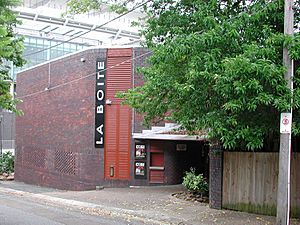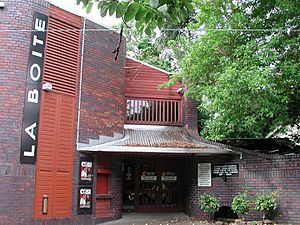La Boite Theatre Building facts for kids
Quick facts for kids La Boite Theatre Building |
|
|---|---|

La Boite Theatre, 2003
|
|
| Location | 69 Hale Street, Petrie Terrace, City of Brisbane, Queensland, Australia |
| Built | 1972 |
| Architect | Blair Wilson |
| Official name: La Boite Theatre | |
| Type | state heritage (built) |
| Designated | 30 January 2004 |
| Reference no. | 602171 |
| Significant period | 1972 (fabric) 1965–ongoing (social) |
| Significant components | auditorium, foyer – entrance |
| Lua error in Module:Location_map at line 420: attempt to index field 'wikibase' (a nil value). | |
The La Boite Theatre Building is a special old theatre building in Petrie Terrace, Brisbane, Australia. It was designed by Blair Wilson and built in 1972. This building is important because it was one of the first theatres in Australia designed for a special type of performance called 'theatre-in-the-round'. It is now listed on the Queensland Heritage Register, which means it's a protected historical site.
Contents
The Story of La Boite Theatre
How the Theatre Company Started
The La Boite Theatre Building was built in 1972 for the Brisbane Repertory Theatre Company. This theatre group started way back in 1925! A group of theatre lovers, led by Barbara Sisley, wanted to share their passion for plays. Their main goal was to "promote the best in dramatic literature and art."
They were quite daring for their time. In 1926, they decided to include at least one Australian play in their yearly shows. In 1931, they held a playwriting competition. The winning play caused a stir because it was so realistic and used strong language! This showed that the company liked to put on modern and exciting theatre. Today, they are Australia's oldest theatre company that has been running without a break.
Finding a Permanent Home
For many years, the Brisbane Repertory Theatre Company performed in different theatres all over Brisbane. But one by one, these theatres started to close down. By 1967, there were no affordable places left in the city centre for them to perform. The company really wanted a permanent home where their theatre could "flourish."
In the late 1950s, the theatre society bought two old wooden houses. They decided to turn one of them into a unique theatre. This new style was called "theatre-in-the-round."
What is Theatre-in-the-Round?
"Theatre-in-the-round" is a special way of putting on a play. Instead of the audience sitting in front of a stage, they sit all around the stage! Imagine the actors performing in the middle, with people watching from every side.
This style was new to Brisbane. It allowed actors and directors to try out exciting new ways of performing. It also needed less fancy equipment and scenery, making it cheaper to set up. The converted house opened in June 1967 and could seat 65 people. Even though it was small and didn't have air conditioning, it was a big artistic success! They named it "La Boite," which means "The Box" in French, because of its simple, box-like shape.
Building a New La Boite
The small converted house was very popular, and the company put on more than 40 plays there. They soon needed more space. So, in 1971, they got permission to build a brand new theatre. This new building would also be a theatre-in-the-round, but it would be designed specifically for that purpose.
Blair Wilson, a Brisbane architect, designed the new theatre. It was the very first theatre in Australia built especially for "arena theatre" (another name for theatre-in-the-round). The Queensland Government helped pay for the building with a grant of $40,000.
To save money, they used "reject bricks" that had small chips or bumps. These bricks gave the building a unique look. Blair Wilson even won an award for his creative use of these bricks! The theatre had a small outdoor area off the entrance, which was a nice place for people to chat during breaks. Inside, the seats were arranged in rows around a central stage.
The new La Boite Theatre officially opened on 11 June 1972. It was a big moment for Australian theatre!
Changes Over Time
Over the years, the La Boite Theatre continued to be a place for new ideas. In 1975, they started a drama project for young children. In 1980, they had their first season of only Australian plays. By 1993, the company became professional, meaning the actors and staff were paid.
As the company grew, they needed even more space. Also, a nearby sports stadium was being built, which made parking difficult for theatre-goers. So, in 2001, the company announced they would move to a new theatre at the Queensland University of Technology's Kelvin Grove campus. This new theatre is called the Roundhouse Theatre.
The original La Boite Theatre Building on Hale Street was then sold and changed into offices for businesses.
What the Building Looks Like
The La Boite Theatre Building truly looks like its name – "The Box"! It's a brick building with rounded corners. It's made of dark bricks that have a cool texture because of how they were laid. The roof is flat and covered with metal.
The building has three levels. On the ground floor, you'll find the main entrance area, called the foyer, and a ticket office. Behind that is the main theatre space, called the auditorium, which can seat 200 people. The stage is in the middle, with seats all around it. There are special tunnels under the seats that actors can use to move around the stage without being seen.
Below the stage, in the basement, there are spaces for rehearsals, workshops, storage, offices, and dressing rooms. Above the stage, there's a gallery area. Outside the foyer, there's a brick-paved courtyard where people could relax.
Why La Boite Theatre is Special
The La Boite Theatre Building was added to the Queensland Heritage Register in 2004. This means it's recognized as an important part of Queensland's history and culture.
- It shows how theatre changed in Queensland: This theatre was a pioneer in bringing the "arena theatre" style to Queensland. This new style made performances more modern, flexible, and personal, helping to make amateur theatre exciting again. It's also important because it was built specifically for a long-running and popular theatre company that has played a big role in the arts in Queensland.
- It's a rare building: The La Boite Theatre is special because it was the first theatre in Queensland designed and built specifically as a theatre-in-the-round.
- It looks great: The design of the La Boite Theatre won an award for its creative use of bricks. Its unique box shape perfectly matches its name, "The Box," which was carried over from the earlier converted cottage theatre.
- It has a strong connection to the community: The La Boite Theatre is strongly linked to the Brisbane Repertory Theatre Company. It was their home for 30 years, and the company even took its name from the building when it became an official organization.
Images for kids



